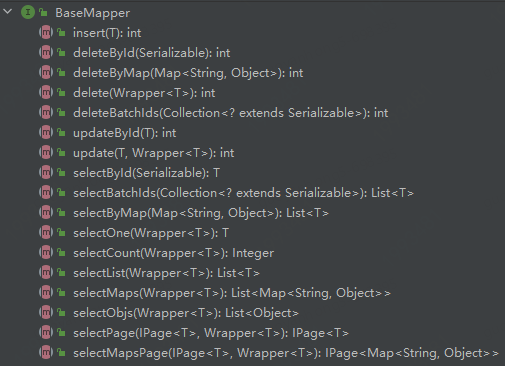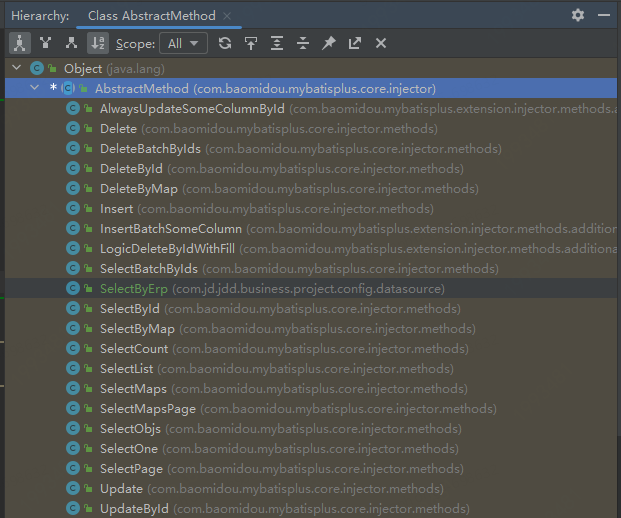mybatisplus 的常用 CRUD 方法
众所周知,mybatisplus 提供了强大的代码生成能力,他默认生成的常用的 CRUD 方法(例如插入、更新、删除、查询等)的定义,能够帮助我们节省很多体力劳动。
他的BaseMapper中定义了这些常用的 CRUD 方法,我们在使用时,继承这个BaseMapper类就默认拥有了这些能力。
如果我们的业务中,需要类似的通用 Sql 时,该如何实现呢?
是每个 Mapper 中都定义一遍类似的 Sql 吗?
显然这是最笨的一种方法。
此时我们可以借助mybatisplus这个成熟框架,来实现我们想要的通用 Sql。
扩展常用 CRUD 方法
新增一个通用 sql
比如有一个这样的需求,项目中所有表或某一些表,都要执行一个类似的查询,如`SelectByErp`,那么可以这样实现。(这是一个最简单的 sql 实现,使用时可以根据业务需求实现更为复杂的 sql:比如多租户系统自动增加租户 id 参数、分库分表系统增加分库分表字段条件判断)
定义一个SelectByErp类,继承AbstractMethod类,并实现injectMappedStatement方法
定义 sql 方法名、sql 模板、实现 sql 的拼接组装
/** * 新增一个通用sql */public class SelectByErp extends AbstractMethod { // 需要查询的列名 private final String erpColumn = "erp"; // sql方法名 private final String method = "selectByErp"; // sql模板 private final String sqlTemplate = "SELECT %s FROM %s WHERE %s=#{%s} %s";
@Override public MappedStatement injectMappedStatement(Class<?> mapperClass, Class<?> modelClass, TableInfo tableInfo) { // 获取需要查询的字段名及属性名 TableFieldInfo erpFiled = getErpProperty(tableInfo); // 拼接组装sql SqlSource sqlSource = new RawSqlSource(configuration, String.format(sqlTemplate, sqlSelectColumns(tableInfo, false), tableInfo.getTableName(), erpFiled.getColumn(), erpFiled.getProperty(), tableInfo.getLogicDeleteSql(true, false)), Object.class); return this.addSelectMappedStatementForTable(mapperClass, method, sqlSource, tableInfo);} /** * 查询erp列信息 */ private TableFieldInfo getErpProperty(TableInfo tableInfo) { List<TableFieldInfo> fieldList = tableInfo.getFieldList(); TableFieldInfo erpField = fieldList.stream().filter(filed -> filed.getColumn().equals(erpColumn)).findFirst().get(); return erpField; }
复制代码
3.定义一个 sql 注入器GyhSqlInjector,添加SelectByErp对象
// 需注入到spring容器中@Componentpublic class GyhSqlInjector extends DefaultSqlInjector { @Override public List<AbstractMethod> getMethodList(Class<?> mapperClass) { List<AbstractMethod> methodList = super.getMethodList(mapperClass); // 增加 SelectByErp对象,程序启动后自动加载 methodList.add(new SelectByErp()); return methodList; }}
复制代码
4.定义一个基础 MapperGyhBaseMapper,添加selectByErp方法
/** * 自定义的通用Mapper */public interface GyhBaseMapper<T> extends BaseMapper<T> { List<T> selectByErp(String erp);}
复制代码
5.应用中需要使用该SelectByErp方法的表,都继承GyhBaseMapper,那么这些表将都拥有了selectByErp这个查询方法,程序启动后会自动为这些表生成该 sql。
public interface XXXMapper extends GyhBaseMapper<XXXTable>
复制代码
添加一个 mybatisplus 已有 sql
1.mybatisplus 常用 CRUD 方法如最上图,这些方法已经默认会自动生成,但 mybatisplus 其实提供了更多的方法,如下图,只要我们在启动时添加进去,就可以使用了。
2.比如我想使用AlwaysUpdateSomeColumnById方法,该方法可以在更新时只更新我需要的字段,不进行全字段更新。添加步骤如下。
3.定义一个 sql 注入器 ,如GyhSqlInjector,添加AlwaysUpdateSomeColumnById对象
@Componentpublic class GyhSqlInjector extends DefaultSqlInjector { @Override public List<AbstractMethod> getMethodList(Class<?> mapperClass) { List<AbstractMethod> methodList = super.getMethodList(mapperClass); // 添加 AlwaysUpdateSomeColumnById 对象 methodList.add(new AlwaysUpdateSomeColumnById()); return methodList; }}
复制代码
4.定义一个基础 Mapper 如GyhBaseMapper,添加alwaysUpdateSomeColumnById方法
/** * 自定义的通用Mapper */public interface GyhBaseMapper<T> extends BaseMapper<T> { int alwaysUpdateSomeColumnById(@Param(Constants.ENTITY) T entity);}
复制代码
5.继承GyhBaseMapper的其他 Mapper,将自动拥有alwaysUpdateSomeColumnById方法
/** * 自定义的通用Mapper */public interface GyhBaseMapper<T> extends BaseMapper<T> { int alwaysUpdateSomeColumnById(@Param(Constants.ENTITY) T entity);}
复制代码
6.继承GyhBaseMapper的其他 Mapper,将自动拥有alwaysUpdateSomeColumnById方法
编辑一个 mybatisplus 已有 sql
1.如果想编辑一个 mybatisplus 已有 sql,比如分库分表系统,执行updateById操作时,虽然主键 Id 已确定,但目标表不确定,此时可能导致该 sql 在多张表上执行,造成资源浪费,并且分库分表字段不可修改,默认的updateById不能用,需要改造。以下以shardingsphere分库分表为例。
2.定义一个UpdateByIdWithSharding类,继承UpdateById类
public class UpdateByIdWithSharding extends UpdateById { private String columnDot = "`"; private YamlShardingRuleConfiguration yamlShardingRuleConfiguration; // 注入shardingsphere的分库分表配置信息 public UpdateByIdWithSharding(YamlShardingRuleConfiguration yamlShardingRuleConfiguration) { this.yamlShardingRuleConfiguration = yamlShardingRuleConfiguration; }
@Override public MappedStatement injectMappedStatement(Class<?> mapperClass, Class<?> modelClass, TableInfo tableInfo) { String tableName = tableInfo.getTableName(); // shardingsphere 分库分表配置信息 Map<String, YamlTableRuleConfiguration> tables = yamlShardingRuleConfiguration.getTables(); // 判断当前表是否设置了分表字段 if (tables.containsKey(tableName)) { YamlTableRuleConfiguration tableRuleConfiguration = tables.get(tableName); // 获取分表字段 String shardingColumn = tableRuleConfiguration.getTableStrategy().getStandard().getShardingColumn(); // 构建sql boolean logicDelete = tableInfo.isLogicDelete(); SqlMethod sqlMethod = SqlMethod.UPDATE_BY_ID; // 增加分表字段判断 String shardingAdditional = getShardingColumnWhere(tableInfo, shardingColumn); // 是否判断逻辑删除字段 final String additional = optlockVersion() + tableInfo.getLogicDeleteSql(true, false); shardingAdditional = shardingAdditional + additional; String sql = String.format(sqlMethod.getSql(), tableInfo.getTableName(), getSqlSet(logicDelete, tableInfo, shardingColumn), tableInfo.getKeyColumn(), ENTITY_DOT + tableInfo.getKeyProperty(), shardingAdditional); SqlSource sqlSource = languageDriver.createSqlSource(configuration, sql, modelClass); return addUpdateMappedStatement(mapperClass, modelClass, sqlMethod.getMethod(), sqlSource); } else { return super.injectMappedStatement(mapperClass, modelClass, tableInfo); } }
/** * where条件增加分表字段 */ private String getShardingColumnWhere(TableInfo tableInfo, String shardingColumn) { StringBuilder shardingWhere = new StringBuilder(); shardingWhere.append(" AND ").append(shardingColumn).append("=#{"); shardingWhere.append(ENTITY_DOT); TableFieldInfo fieldInfo = tableInfo.getFieldList().stream() .filter(f -> f.getColumn().replaceAll(columnDot, StringUtils.EMPTY).equals(shardingColumn)) .findFirst().get(); shardingWhere.append(fieldInfo.getEl()); shardingWhere.append("}"); return shardingWhere.toString(); }
/** * set模块去掉分表字段 */ public String getSqlSet(boolean ignoreLogicDelFiled, TableInfo tableInfo, String shardingColumn) { List<TableFieldInfo> fieldList = tableInfo.getFieldList(); // 去掉分表字段的set设置,即不修改分表字段 String rmShardingColumnSet = fieldList.stream() .filter(i -> ignoreLogicDelFiled ? !(tableInfo.isLogicDelete() && i.isLogicDelete()) : true) .filter(i -> !i.getColumn().equals(shardingColumn)) .map(i -> i.getSqlSet(ENTITY_DOT)) .filter(Objects::nonNull).collect(joining(NEWLINE)); return rmShardingColumnSet; }}
复制代码
3.定义一个 sql 注入器GyhSqlInjector,添加UpdateByIdWithSharding对象
// 需注入到spring容器中@Componentpublic class GyhSqlInjector extends DefaultSqlInjector { /** * shardingsphere 配置信息 */ @Autowired private YamlShardingRuleConfiguration yamlShardingRuleConfiguration;
@Override public List<AbstractMethod> getMethodList(Class<?> mapperClass) { List<AbstractMethod> methodList = super.getMethodList(mapperClass); // 添加 UpdateByIdWithSharding 对象,并注入分库分表信息 methodList.add(new UpdateByIdWithSharding(yamlShardingRuleConfiguration)); return methodList; }}
复制代码
4.定义一个基础 MapperGyhBaseMapper,添加新的selectById方法
/** * 自定义的通用Mapper */public interface GyhBaseMapper<T> extends BaseMapper<T> { int updateById(@Param(Constants.ENTITY) T entity);}
复制代码
5.所有参与分表的表,在定义 Mapper 时继承GyhBaseMapper,那么在使用他的updateById方法时,将自动增加分库分表判断,准确命中目标表,减少其他分表查询的资源浪费。
以上是针对mybatisplus的一些简单改造,希望能为你提供一点点帮助~
作者:京东科技 郭艳红
来源:京东云开发者社区 转载请注明来源














评论